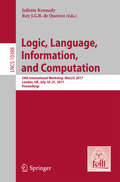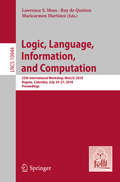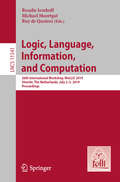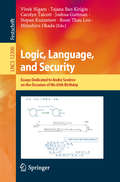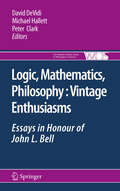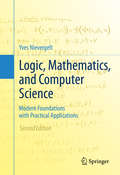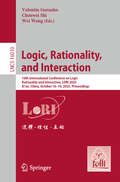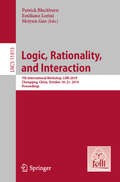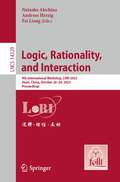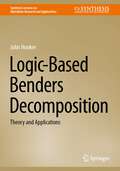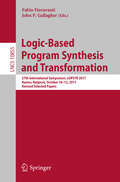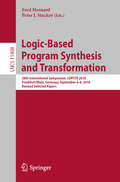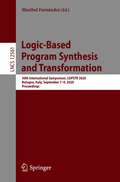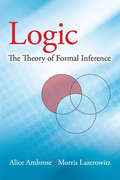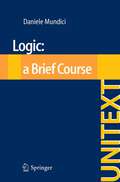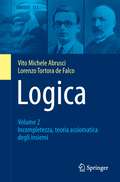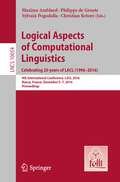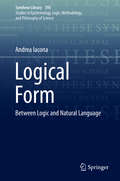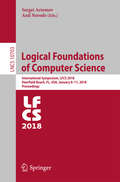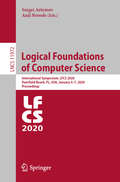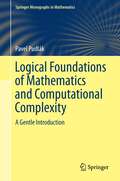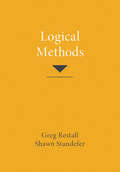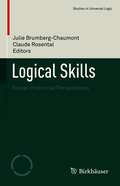- Table View
- List View
Logic, Language, Information, and Computation
by Juliette Kennedy Ruy J. G. B. QueirozEdited in collaboration with FoLLI, the Association of Logic, Language and Information this book constitutes the refereed proceedings of the 21st Workshop on Logic, Language, Information and Communication, WoLLIC 2014, held in Valparaiso, Chile, in September 2014. The 15 contributed papers presented together with 6 invited lectures were carefully reviewed and selected from 29 submissions. The focus of the workshop was on the following subjects Inter-Disciplinary Research involving Formal Logic, Computing and Programming Theory, and Natural Language and Reasoning.
Logic, Language, Information, and Computation: 25th International Workshop, WoLLIC 2018, Bogota, Colombia, July 24-27, 2018, Proceedings (Lecture Notes in Computer Science #10944)
by Ruy De Queiroz Lawrence S. Moss Maricarmen MartinezEdited in collaboration with FoLLI, the Association of Logic, Language and Information this book constitutes the refereed proceedings of the 25th Workshop on Logic, Language, Information and Communication, WoLLIC 2018, held inBogota, Colombia, in July 2018. The 16 full papers together with 3 short papers and 3 invited talks presented were fully reviewed and selected from 30 submissions. The vision for the conference is to provide an annual forum which is large enough to provide meaningful interactions between logic and the sciences related to information and computation.
Logic, Language, Information, and Computation: 26th International Workshop, WoLLIC 2019, Utrecht, The Netherlands, July 2-5, 2019, Proceedings (Lecture Notes in Computer Science #11541)
by Ruy De Queiroz Rosalie Iemhoff Michael MoortgatEdited in collaboration with FoLLI, the Association of Logic, Language and Information this book constitutes the refereed proceedings of the 26th Workshop on Logic, Language, Information and Communication, WoLLIC 2019, held in Utrecht, The Netherlands, in July 2019. The 41 full papers together with 6 invited lectures presented were fully reviewed and selected from 60 submissions. The idea is to have a forum which is large enough in the number of possible interactions between logic and the sciences related to information and computation, and yet is small enough to allow for concrete and useful interaction among participants.
Logic, Language, and Security: Essays Dedicated to Andre Scedrov on the Occasion of His 65th Birthday (Lecture Notes in Computer Science #12300)
by Carolyn Talcott Vivek Nigam Tajana Ban Kirigin Joshua Guttman Stepan Kuznetsov Boon Thau Loo Mitsuhiro OkadaThis Festschrift was published in honor of Andre Scedrov on the occasion of his 65th birthday. The 11 technical papers and 3 short papers included in this volume show the many transformative discoveries made by Andre Scedrov in the areas of linear logic and structural proof theory; formal reasoning for networked systems; and foundations of information security emphasizing cryptographic protocols. These papers are authored by researchers around the world, including North America, Russia, Europe, and Japan, that have been directly or indirectly impacted by Andre Scedrov. The chapter “A Small Remark on Hilbert's Finitist View of Divisibility and Kanovich-Okada-Scedrov's Logical Analysis of Real-Time Systems” is available open access under a CC BY 4.0 license at link.springer.com.
Logic, Mathematics, Philosophy, Vintage Enthusiasms
by Peter Clark David Devidi Michael HallettThe volume includes twenty-five research papers presented as gifts to John L. Bell to celebrate his 60th birthday by colleagues, former students, friends and admirers. Like Bell's own work, the contributions cross boundaries into several inter-related fields. The contributions are new work by highly respected figures, several of whom are among the key figures in their fields. Some examples: in foundations of maths and logic (William Lawvere, Peter Aczel, Graham Priest, Giovanni Sambin); analytical philosophy (Michael Dummett, William Demopoulos), philosophy of science (Michael Redhead, Frank Arntzenius), philosophy of mathematics (Michael Hallett, John Mayberry, Daniel Isaacson) and decision theory and foundations of economics (Ken Bimore). Most articles are contributions to current philosophical debates, but contributions also include some new mathematical results, important historical surveys, and a translation by Wilfrid Hodges of a key work of arabic logic.
Logic, Mathematics, and Computer Science
by Yves NievergeltThis text for the first or second year undergraduate in mathematics, logic, computer science, or social sciences, introduces the reader to logic, proofs, sets, and number theory. It also serves as an excellent independent study reference and resource for instructors. Adapted from Foundations of Logic and Mathematics: Applications to Science and Cryptography © 2002 BirkhÓ"user, this second edition provides a modern introduction to the foundations of logic, mathematics, and computers science, developing the theory that demonstrates construction of all mathematics and theoretical computer science from logic and set theory. The focuses is on foundations, with specific statements of all the associated axioms and rules of logic and set theory, and provides complete details and derivations of formal proofs. Copious references to literature that document historical development is also provided. Answers are found to many questions that usually remain unanswered: Why is the truth table for logical implication so unintuitive? Why are there no recipes to design proofs? Where do these numerous mathematical rules come from? What issues in logic, mathematics, and computer science still remain unresolved? And the perennial question: In what ways are we going to use this material? Additionally, the selection of topics presented reflects many major accomplishments from the twentieth century and includes applications in game theory and Nash's equilibrium, Gale and Shapley's match making algorithms, Arrow's Impossibility Theorem in voting, to name a few. From the reviews of the first edition: ". . . All the results are proved in full detail from first principles. . . remarkably, the arithmetic laws on the rational numbers are proved, step after step, starting from the very definitions!. . . This is a valuable reference text and a useful companion for anybody wondering how basic mathematical concepts can be rigorously developed within set theory. " --MATHEMATICAL REVIEWS "Rigorous and modern in its theoretical aspect, attractive as a detective novel in its applied aspects, this paper book deserves the attention of both beginners and advanced students in mathematics, logic and computer sciences as well as in social sciences. " --Zentralblatt MATH
Logic, Rationality, and Interaction: 10th International Conference on Logic, Rationality and Interaction, LORI 2025, Xi’an, China, October 16–19, 2025, Proceedings (Lecture Notes in Computer Science #16010)
by Wei Wang Valentin Goranko Chenwei ShiThis LNCS book is part of the FOLLI book series and constitutes the proceedings of the 10th International Conference on Logic, Rationality, and Interaction, LORI 2025, held in Xi&’an, China, in October 2025. The 14 full papers presented in this book were carefully reviewed and selected from 47 submissions.The topics addressed in this program effectively showcase the breadth and depth characteristic of the LORI conference series, including contributions on dynamic epistemic logic, nonmonotonic reasoning, belief revision theory, decision theory, causal inference, social epistemology and so on.
Logic, Rationality, and Interaction: 7th International Workshop, LORI 2019, Chongqing, China, October 18–21, 2019, Proceedings (Lecture Notes in Computer Science #11813)
by Patrick Blackburn Emiliano Lorini Meiyun GuoThis LNCS book is part of the FOLLI book series and constitutes the proceedings of the 7th International Workshop on Logic, Rationality, and Interaction, LORI 2019, held in Chongqing, China, in October 2019.The 31 papers presented in this book were carefully reviewed and selected from 56 submissions. They focus on the following topics: agency; argumentation and agreement; belief revision and belief merging; belief representation; cooperation; decision making and planning; natural language; philosophy and philosophical logic; and strategic reasoning.
Logic, Rationality, and Interaction: 9th International Workshop, LORI 2023, Jinan, China, October 26–29, 2023, Proceedings (Lecture Notes in Computer Science #14329)
by Andreas Herzig Natasha Alechina Fei LiangThis LNCS book is part of the FOLLI book series and constitutes the proceedings of the 9th International Workshop on Logic, Rationality, and Interaction, LORI 2023, held in Jinan, China, in October 2023.The 15 full papers presented together with 7 short papers in this book were carefully reviewed and selected from 40 submissions. The workshop covers a wide range on the following topics such as agency; argumentation and agreement; belief representation; probability and uncertainty; belief revision and belief merging; knowledge and action; dynamics of informational attitudes; intentions, plans, and goals; decision making and planning; preference and utility; cooperation; strategic reasoning and game theory; epistemology; social choice; social interaction; speech acts; knowledge representation; norms and normative systems; natural language; rationality; philosophical logic.
Logic-Based Benders Decomposition: Theory and Applications (Synthesis Lectures on Operations Research and Applications)
by John HookerThis book is the first comprehensive guide to logic-based Benders decomposition (LBBD), a general and versatile method for breaking large, complex optimization problems into components that are small enough for practical solution. The author introduces logic-based Benders decomposition for optimization, which substantially generalizes the classical Benders method. It can reduce solution times by orders of magnitude and allows decomposition to be applied to a much wider variety of optimization problems. On the theoretical side, this book provides a full account of inference duality concepts that underlie LBBD, as well as a description of how LBBD can be combined with stochastic and robust optimization, heuristic methods, and decision diagrams. It also clarifies the connection between LBBD and combinatorial Benders cuts for mixed integer programming. On the practical side, it explains how LBBD has been applied to a rapidly growing variety of problem domains. After describing basic theory, this book provides a comprehensive review of the rapidly growing literature that describes these applications, in each case explaining how LBBD is adapted to the problem at hand. In doing so this work provides a sourcebook of ideas for applying LBBD to new problems as they arise.
Logic-Based Program Synthesis and Transformation: 27th International Symposium, LOPSTR 2017, Namur, Belgium, October 10-12, 2017, Revised Selected Papers (Lecture Notes in Computer Science #10855)
by John P. Gallagher Fabio FioravantiThis book constitutes the thoroughly refereed post-conference proceedings of the 27th International Symposium on Logic-Based Program Synthesis and Transformation, LOPSTR 2017, held in Namur, Belgium, in October 2017. The 19 revised full papers were carefully reviewed and selected from 29 submissions. In addition to the 19 revised papers, this volume includes the abstracts of the invited talks by three outstanding speakers: Sumit Gulwani, Marieke Huisman, and Grigore Roşu. The aim of the LOPSTR series is to stimulate and promote international research and collaboration on logic-based program development. LOPSTR is open to contributions in all aspects of logic-based program development, all stages of the software life cycle, and issues of both programming-in-the-small and programming-in-the-large. LOPSTR traditionally solicits contributions, in any language paradigm, in the areas of synthesis, specification, transformation, analysis and verification, specialization, testing and certification, composition, program/model manipulation, optimization, transformational techniques in SE, inversion, applications, and tools.
Logic-Based Program Synthesis and Transformation: 28th International Symposium, LOPSTR 2018, Frankfurt/Main, Germany, September 4-6, 2018, Revised Selected Papers (Lecture Notes in Computer Science #11408)
by Fred Mesnard Peter J. StuckeyThis book constitutes the thoroughly refereed post-conference proceedings of the 28th International Symposium on Logic-Based Program Synthesis and Transformation, LOPSTR 2018, held in Frankfurt/Main, Germany, in September 2018.The 11 revised full papers were carefully reviewed and selected from 29 submissions. In addition to the 11 papers, this volume includes 3 abstracts of invited talks and 2 abstracts of invited tutorials. The papers are grouped into the following topics: analysis of term rewriting; logic-based distributed/concurrent programming; analysis of logic programming; and program analysis.
Logic-Based Program Synthesis and Transformation: 30th International Symposium, LOPSTR 2020, Bologna, Italy, September 7–9, 2020, Proceedings (Lecture Notes in Computer Science #12561)
by Maribel FernándezThis book constitutes the refereed proceedings of the 30th International Conference on Logic-Based Program Synthesis and Transformation, LOPSTR 2020, which was held during September 7-9, 2020. The 15 papers presented in this volume were carefully reviewed and selected from a total of 31 submissions. The book also contains two invited talks in full paper length. The contributions were organized in topical sections named: rewriting; unification; types; verification; model checking and probabilistic programming; program analysis and testing; and logics.
Logic: 15th International Workshop, Wollic 2008 Edinburgh, Uk, July 1-4, 2008, Proceedings (Lecture Notes In Computer Science Ser. #5110)
by Wilfrid HodgesIf a man supports Arsenal one day and Spurs the next then he is fickle but not necessarily illogical. From this starting point, and assuming no previous knowledge of logic, Wilfrid Hodges takes the reader through the whole gamut of logical expressions in a simple and lively way. Readers who are more mathematically adventurous will find optional sections introducing rather more challenging material. 'A lively and stimulating book' Philosophy
Logic: The Theory of Formal Inference
by Morris Lazerowitz Alice AmbroseGeared toward college undergraduates new to the subject, this concise introduction to formal logic was written by Alice Ambrose and Morris Lazerowitz, a pair of noted scholars and prolific authors in this field. A preliminary section opens the subject under the heading of truth-functions. Two subsequent parts on quantification and classes, each subdivided into numerous brief specifics, complete the overview. Suitable for students of philosophy as well as mathematics, the three-part treatment begins with the intuitive development of the standard theory of sentential connectives (called "operators"). The theory is further developed with the assistance of truth-tables and ultimately as a logistic system. Part II explores first-order quantification theory. In addition to examining most of the familiar laws that can be expressed by monadic formulas, the text addresses polyadic principles and the theories of identity and descriptions. Part III focuses on elementary concepts of classes, from class membership and class inclusion to the algebra of classes. Each part concludes with a series of exercises.
Logic: a Brief Course
by Daniele MundiciThis short book, geared towards undergraduate students of computer science and mathematics, is specifically designed for a first course in mathematical logic. A proof of Gödel's completeness theorem and its main consequences is given using Robinson's completeness theorem and Gödel's compactness theorem for propositional logic. The reader will familiarize himself with many basic ideas and artifacts of mathematical logic: a non-ambiguous syntax, logical equivalence and consequence relation, the Davis-Putnam procedure, Tarski semantics, Herbrand models, the axioms of identity, Skolem normal forms, nonstandard models and, interestingly enough, proofs and refutations viewed as graphic objects. The mathematical prerequisites are minimal: the book is accessible to anybody having some familiarity with proofs by induction. Many exercises on the relationship between natural language and formal proofs make the book also interesting to a wide range of students of philosophy and linguistics.
Logica: Volume 2 - Incompletezza, teoria assiomatica degli insiemi (UNITEXT #111)
by Vito Michele Abrusci Lorenzo Tortora de FalcoL'opera si propone come testo di riferimento per acquisire una solida preparazione specialistica nella Logica, presentando in maniera rigorosa ed innovativa argomenti tradizionalmente affrontati nei corsi universitari di secondo livello. Questo secondo volume, che completa l'opera, presenta le basi della teoria della ricorsività, l'aritmetica di Peano ed i teoremi di incompletezza, gli assiomi della teoria assiomatica degli insiemi di Zermelo-Fraenkel e la teoria degli ordinali e dei cardinali che ne deriva.
Logical Aspects of Computational Linguistics. Celebrating 20 Years of LACL: 9th International Conference, LACL 2016, Nancy, France, December 5-7, 2016, Proceedings (Lecture Notes in Computer Science #10054)
by Sylvain Pogodalla Maxime Amblard Christian Retoré Philippe De GrooteEdited under the auspices of the Association of Logic, Language andInformation (FoLLI), this book constitutes the refereed proceedings ofthe 20th anniversary of the International Conference on LogicalAspects of Computational Linguistics, LACL 2016, held in LORIA Nancy,France, in December 2016. The 19 contributed papers, presentedtogether with 4 invited papers and 6 abstracts, were carefullyreviewed and selected from 38 submissions. The focus of the conferenceis the use of type theoretic, proof theoretic, and model theoreticmethods for describing and formalising natural language syntax,semantics, and pragmatics as well as the implementation of thecorresponding tools.
Logical Form: Between Logic and Natural Language (Synthese Library #393)
by Andrea IaconaLogical form has always been a prime concern for philosophers belonging to the analytic tradition. For at least one century, the study of logical form has been widely adopted as a method of investigation, relying on its capacity to reveal the structure of thoughts or the constitution of facts. This book focuses on the very idea of logical form, which is directly relevant to any principled reflection on that method. Its central thesis is that there is no such thing as a correct answer to the question of what is logical form: two significantly different notions of logical form are needed to fulfill two major theoretical roles that pertain respectively to logic and to semantics. This thesis has a negative and a positive side. The negative side is that a deeply rooted presumption about logical form turns out to be overly optimistic: there is no unique notion of logical form that can play both roles. The positive side is that the distinction between two notions of logical form, once properly spelled out, sheds light on some fundamental issues concerning the relation between logic and language.
Logical Foundations of Computer Science
by Sergei Artemov Anil NerodeThis book constitutes the refereed proceedings of the International Symposium on Logical Foundations of Computer Science, LFCS 2007, held in New York, NY, USA in June 2007. The volume presents 36 revised refereed papers that address all current aspects of logic in computer science.
Logical Foundations of Computer Science: International Symposium, LFCS 2020, Deerfield Beach, FL, USA, January 4–7, 2020, Proceedings (Lecture Notes in Computer Science #11972)
by Sergei Artemov Anil NerodeThis book constitutes the refereed proceedings of the International Symposium on Logical Foundations of Computer Science, LFCS 2020, held in Deerfield Beach, FL, USA, in January 2020. The 17 revised full papers were carefully reviewed and selected from 30 submissions. The scope of the Symposium is broad and includes constructive mathematics and type theory; homotopy type theory; logic, automata, and automatic structures; computability and randomness; logical foundations of programming; logical aspects of computational complexity; parameterized complexity; logic programming and constraints; automated deduction and interactive theorem proving; logical methods in protocol and program verification; logical methods in program specification and extraction; domain theory logics; logical foundations of database theory; equational logic and term rewriting; lambda and combinatory calculi; categorical logic and topological semantics; linear logic; epistemic and temporal logics; intelligent and multiple-agent system logics; logics of proof and justification; non-monotonic reasoning; logic in game theory and social software; logic of hybrid systems; distributed system logics; mathematical fuzzy logic; system design logics; other logics in computer science.
Logical Foundations of Mathematics and Computational Complexity
by Pavel PudlákThe two main themes of this book, logic and complexity, are both essential for understanding the main problems about the foundations of mathematics. Logical Foundations of Mathematics and Computational Complexity covers a broad spectrum of results in logic and set theory that are relevant to the foundations, as well as the results in computational complexity and the interdisciplinary area of proof complexity. The author presents his ideas on how these areas are connected, what are the most fundamental problems and how they should be approached. In particular, he argues that complexity is as important for foundations as are the more traditional concepts of computability and provability. Emphasis is on explaining the essence of concepts and the ideas of proofs, rather than presenting precise formal statements and full proofs. Each section starts with concepts and results easily explained, and gradually proceeds to more difficult ones. The notes after each section present some formal definitions, theorems and proofs. Logical Foundations of Mathematics and Computational Complexity is aimed at graduate students of all fields of mathematics who are interested in logic, complexity and foundations. It will also be of interest for both physicists and philosophers who are curious to learn the basics of logic and complexity theory.
Logical Methods
by Greg Restall Shawn StandeferAn accessible introduction to philosophical logic, suitable for undergraduate courses and above.Rigorous yet accessible, Logical Methods introduces logical tools used in philosophy—including proofs, models, modal logics, meta-theory, two-dimensional logics, and quantification—for philosophy students at the undergraduate level and above. The approach developed by Greg Restall and Shawn Standefer is distinct from other texts because it presents proof construction on equal footing with model building and emphasizes connections to other areas of philosophy as the tools are developed. Throughout, the material draws on a broad range of examples to show readers how to develop and master tools of proofs and models for propositional, modal, and predicate logic; to construct and analyze arguments and to find their structure; to build counterexamples; to understand the broad sweep of formal logic&’s development in the twentieth and twenty-first centuries; and to grasp key concepts used again and again in philosophy. This text is essential to philosophy curricula, regardless of specialization, and will also find wide use in mathematics and computer science programs. Features:An accessible introduction to proof theory for readers with no background in logicCovers proofs, models, modal logics, meta-theory, two-dimensional logics, quantification, and many other topicsProvides tools and techniques of particular interest to philosophers and philosophical logiciansFeatures short summaries of key concepts and skills at the end of each chapterOffers chapter-by-chapter exercises in two categories: basic, designed to reinforce important ideas; and challenge, designed to push students&’ understanding and developing skills in new directions
Logical Modalities from Aristotle to Carnap
by Max CresswellInterest in the metaphysics and logic of possible worlds goes back at least as far as Aristotle, but few books address the history of these important concepts. This volume offers new essays on the theories about the logical modalities (necessity and possibility) held by leading philosophers from Aristotle in ancient Greece to Rudolf Carnap in the twentieth century. The story begins with an illuminating discussion of Aristotle's views on the connection between logic and metaphysics, continues through the Stoic and mediaeval (including Arabic) traditions, and then moves to the early modern period with particular attention to Locke and Leibniz. The views of Kant, Peirce, C. I. Lewis and Carnap complete the volume. Many of the essays illuminate the connection between the historical figures studied, and recent or current work in the philosophy of modality. The result is a rich and wide-ranging picture of the history of the logical modalities.
Logical Skills: Social-Historical Perspectives (Studies in Universal Logic)
by Claude Rosental Julie Brumberg-ChaumontThis contributed volume explores the ways logical skills have been perceived over the course of history. The authors approach the topic from the lenses of philosophy, anthropology, sociology, and history to examine two opposing perceptions of logic: the first as an innate human ability and the second as a skill that can be learned and mastered. Chapters focus on the social and political dynamics of the use of logic throughout history, utilizing case studies and critical analyses.Specific topics covered include:the rise of logical skillsproblems concerning medieval notions of idiocy and rationalitydecolonizing natural logicnatural logic and the course of timeLogical Skills: Social-Historical Perspectives will appeal to undergraduate and graduate students, as well as researchers in the fields of history, sociology, philosophy, and logic. Psychology and colonial studies scholars will also find this volume to be of particular interest.
